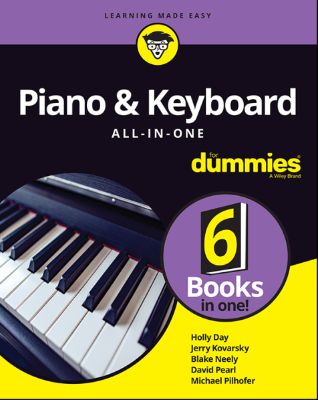Piano & Keyboard All-in-One For Dummies
2.890 kr.

Lýsing:
Your complete guide to playing the keys Making beautiful music on a keyboard or piano requires some know-how and practice. This book offers guidance on how to get the most out of your time learning to play the keys. With six hands-on books wrapped up in one, you'll get a deep guide to the techniques the pros use. Discover the details of music theory and reading music, explore different musical genres, and use practice exercises to improve quickly.
Annað
- Höfundar: Holly Day, Jerry Kovarsky, Blake Neely, David Pearl, Michael Pilhofer
- Útgáfa:2
- Útgáfudagur: 2020-07-10
- Hægt að prenta út 10 bls.
- Hægt að afrita 2 bls.
- Format:ePub
- ISBN 13: 9781119700852
- Print ISBN: 9781119700845
- ISBN 10: 111970085X
Efnisyfirlit
- Cover
- Introduction
- About This Book
- Foolish Assumptions
- Icons Used in This Book
- Beyond the Book
- Where to Go from Here
- Book 1: Piano & Keyboard 101
- Chapter 1: Warming Up to the Piano and Keyboard
- What’s So Special About the Piano?
- Why People Learn to Play the Piano (and Why They Often Quit)
- Getting to Know the Piano as an Instrument
- Understanding the Language of Music
- The Best Way to Play
- What You Already Know About Playing the Piano
- Electronic Keyboards and other Keyboard Instruments
- Making the Most of Your Keyboard’s Basic Features
- Delving into More Advanced Digital Features
- Practicing with and without Help
- Chapter 2:
- Acoustic Pianos
- Electro-Mechanical Keyboards
- Electronic Keyboards
- Appreciating How Digital Keyboards Make So Many Sounds
- Considering Key Feel and Response
- Paying Attention to Polyphony
- Chapter 3: Choosing and Buying Your Keyboard
- First Things First: Acoustic or Electric (or Both)?
- Looking At What’s Important for the Beginner
- Playing Well With Others and Alone
- Picking the Perfect Acoustic Piano
- Selecting a Digital Keyboard That Lasts
- Before You Drive It Off the Lot: Sealing the Deal
- The MIDI Places You Can Go
- Chapter 4: The Setup and Care of Your Instrument
- Unboxing Your New Keyboard
- Providing a Good Place to Put It
- Making It Shine
- Calling In a Pro for Tuning, Check-Ups, and Serious Repairs
- Setting Up Your Keyboard
- Hook Me Up: Keyboard Connections
- Protecting Your Investment: Care and Upkeep
- Solving Minor Technical Problems
- Chapter 5: Getting Comfy at the Keyboard
- Blake’s E-Z Key Finder
- What Your Parents Never Told You About Posture
- It’s All in the Hands
- Pedal Power: Getting Your Feet in on the Action
- Chapter 1: Warming Up to the Piano and Keyboard
- Chapter 1: Looking at Notes and Beats
- Meeting the Beat
- Recognizing Notes and Note Values
- Extending Notes with Dots and Ties
- Mixing All the Note Values Together
- Chapter 2: Stopping for a Rest
- Getting to Know the Rests
- Practicing Beats with Notes and Rests
- Chapter 3: Tempo, Measures, and Time Signatures
- Playing Fast and Slow: Tempo
- Grouping Beats into Measures
- Counting Out Common Time Signatures
- Chapter 4: Navigating Sheet Music
- Meeting the Staff, Clefs, and Notes
- Identifying Half Steps, Whole Steps, and Accidentals on the Staff
- Musical Punctuation: Bar Lines
- Chapter 5: Varying Beats and Rhythms
- Getting a Jump on the Start: Pickup Beats and Measures
- Adding Time to Your Notes with Ties and Dots
- Playing Offbeat Rhythms
- Playing Songs with Challenging Rhythms
- Chapter 1: Playing a Melody
- Let Your Fingers Do the Walking
- Positions, Everyone!
- Cross Your Fingers and Hope It Works
- Playing Melodies in the Right Hand
- Chapter 2: Working with Scales
- Building a Scale, Step-by-Step
- Introducing Major Scales
- Introducing Minor Scales
- Checking Out Blues Scales
- Playing Songs Made of Scales
- Chapter 3: Adding the Left Hand
- Exploring the Keyboard’s West Side
- Left-Hand Melodies
- South-Paw Scales
- Accompaniment Patterns
- Adding the Left Hand to the Right Hand
- Playing Songs with Both Hands
- Chapter 4: Examining Form: Melody, Harmony, and Song Form
- Shaping the Melody
- Measuring Melodic Intervals
- Combining Notes for Harmonic Intervals
- Working with Musical Phrases and Periods
- Linking Musical Parts to Create Forms
- Playing Songs with More Harmony
- Chapter 5: Keys, Key Signatures, and the Circle of Fifths
- Home Sweet Home Key
- The Circle of Fifths
- Reviewing All the Key Signatures
- Playing Songs with Key Signatures
- Chapter 6: Building Chords to Accompany Melodies
- The Anatomy of a Triad
- Starting Out with Major Chords
- Branching Out with Minor Chords
- Exploring Other Types of Chords
- Adding the Seventh for Four-Note Chords
- Reading Chord Symbols
- Relating Chords to a Scale or Key Signature
- Rearranging the Order of the Notes: Chord Inversions
- Playing Songs with Chords
- Chapter 1: Adding Effects and Flair to Your Piano Playing
- Dynamically Speaking
- Articulate the Positive
- Control the Tempo
- Pedal Power
- Touching on Grace Notes
- Just Trillin’
- Don’t Miss the Gliss
- Trembling Tremolos
- Dressing Up Your Songs
- Chapter 2: Getting into the Groove
- Great Left-Hand Accompaniment Patterns
- Applying Great Intros and Finales
- Playing Songs with Left-Hand Grooves
- Chapter 3: Going Classical
- Counterpoint as a Classical Revelation
- Sussing Out the Sonata
- Rounding Up the Rondo
- Figuring Out the Fugue
- Combining Forms into a Symphony
- Observing Other Classical Forms
- Chapter 4: Perusing Popular Genres and Forms
- Feeling the Blues
- Having Fun with Rock and Pop
- Pop! Goes the Piano
- A Little Bit Country
- Improvising with Jazz
- Soul Searching
- Chapter 1: Developing Hand Technique
- Passing Over and Crossing Under
- Playing Intervals
- Playing Chords Without Tension
- Chapter 2: Extending Your Scales
- The 12 Major, Harmonic Minor, and Melodic Minor Scales
- The Three Diminished Scales
- The Chromatic Scale
- The 12 Blues Scales
- Gaining Greater Command of Scales
- Performance Piece: “Variations on ‘Twinkle, Twinkle, Little Star’”
- Chapter 3: Improving Finger Coordination and Footwork
- Parallel Movement at the Octave
- Parallel Movement at the Interval
- Contrary Motion Away from the Center
- Contrary Motion Toward the Center
- Combination Movement Exercise
- Performance Piece: “Turkey in the Straw”
- Using the Damper Pedal
- Pedaling Chords
- Uniform Pedal Changes on One Line
- Varied Pedal Changes on One Line
- Pedaling for Effect
- Sustaining as the Hands Move
- Performance Piece: “Simple Gifts”
- Chapter 4: Jumping Across the Keyboard
- Jumping and Landing Accuracy
- Jumping with Both Hands Together
- Left-Hand Accompaniment Patterns
- Performance Piece: “Lily Pad Rag”
- Chapter 5: Exercising with Arpeggios and Alternating Hands
- Finger Jumps
- The Arpeggiator
- Broken Chords
- Performance Piece: “Harp Heaven”
- Playing with Alternating Hands: Hand-to-Hand Scale Handoffs
- Chapter 6: Stepping Up to Octaves and Chord Progressions
- Opening Up to the Octave
- Octave Jumps
- Octave Chords
- Performance Piece: “Schumann’s Octave Workout”
- Seventh Chord Progressions
- Chord Cadences, Familiar Patterns
- Extended Chord Progressions
- Chapter 1: Choosing Sounds and Ef fects
- First Things First: Understanding Some Important Terminology
- Knowing and Using Effects
- Meeting the Main Types of Effects
- Choosing Effects for Each Type Of Sound
- Chapter 2: Adding Accompaniment, Rhythm Patterns, and Arpeggiation
- Getting Your Groove On: Working with Onboard Drum Rhythms
- Playing with Accompaniment
- Letting the Keyboard Make the Choices for You
- Using Some Fancy Extras
- Exploring Arpeggiation
- Exploring More Arpeggiator Features
- Trying Out Some Different Sounds: Matching Sounds and Arp Patterns
- Adding Fun Sound and Effects Tweaks
- Chapter 3: Recording and Editing Your Sounds
- Audio Recording versus MIDI Recording
- Capturing What You Hear As It Happens: One-Pass Recording
- Recording Multitrack MIDI
- Refining Your MIDI Recordings
- Trying Some Common Sound Edits
- Getting Your Song out of the Keyboard and into the World
- Chapter 4: Using Onboard Learning Systems
- Working with Built-In Songs
- Introducing Casio’s Step-up Lesson System
- Exploring Yamaha’s Educational Suite Lesson System
- Chapter 5: Playing Along with Recordings and Using Music Software
- Exploring the Advantages of Playing Along
- Connecting an Audio Device to Your Keyboard to Hear Both Together
- Getting in Tune
- Figuring Out a Song You Don’t Know
- The Computer Connection: Using Software to Enhance Your Music-Making
- Connecting Your Keyboard to Your Computer
- Hooking Up to Your iPad
- Exploring Popular Types of Music Software
- Discovering What’s on the Audio Tracks
- Customer Care
UM RAFBÆKUR Á HEIMKAUP.IS
Bókahillan þín er þitt svæði og þar eru bækurnar þínar geymdar. Þú kemst í bókahilluna þína hvar og hvenær sem er í tölvu eða snjalltæki. Einfalt og þægilegt!Rafbók til eignar
Rafbók til eignar þarf að hlaða niður á þau tæki sem þú vilt nota innan eins árs frá því bókin er keypt.
Þú kemst í bækurnar hvar sem er
Þú getur nálgast allar raf(skóla)bækurnar þínar á einu augabragði, hvar og hvenær sem er í bókahillunni þinni. Engin taska, enginn kyndill og ekkert vesen (hvað þá yfirvigt).
Auðvelt að fletta og leita
Þú getur flakkað milli síðna og kafla eins og þér hentar best og farið beint í ákveðna kafla úr efnisyfirlitinu. Í leitinni finnur þú orð, kafla eða síður í einum smelli.
Glósur og yfirstrikanir
Þú getur auðkennt textabrot með mismunandi litum og skrifað glósur að vild í rafbókina. Þú getur jafnvel séð glósur og yfirstrikanir hjá bekkjarsystkinum og kennara ef þeir leyfa það. Allt á einum stað.
Hvað viltu sjá? / Þú ræður hvernig síðan lítur út
Þú lagar síðuna að þínum þörfum. Stækkaðu eða minnkaðu myndir og texta með multi-level zoom til að sjá síðuna eins og þér hentar best í þínu námi.
Fleiri góðir kostir
- Þú getur prentað síður úr bókinni (innan þeirra marka sem útgefandinn setur)
- Möguleiki á tengingu við annað stafrænt og gagnvirkt efni, svo sem myndbönd eða spurningar úr efninu
- Auðvelt að afrita og líma efni/texta fyrir t.d. heimaverkefni eða ritgerðir
- Styður tækni sem hjálpar nemendum með sjón- eða heyrnarskerðingu
- Gerð : 208
- Höfundur : 10816
- Útgáfuár : 2014
- Leyfi : 380


